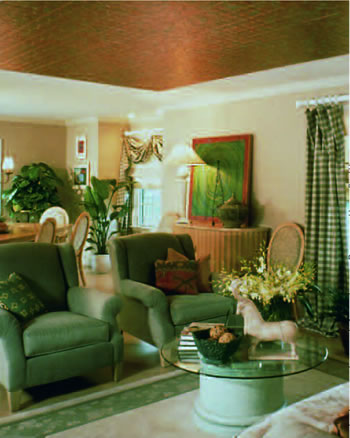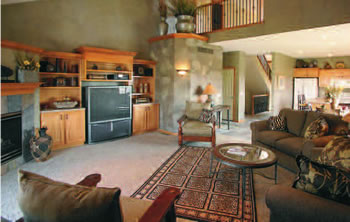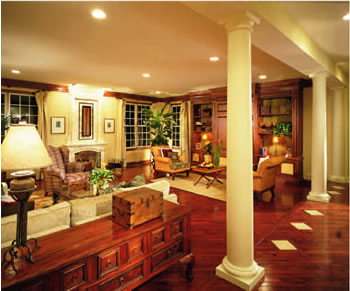Creating Intimacy in Open Floor Plans

A decorative ceiling over the conversation area visually divides this large space.
Over the last two decades, new homes and home plans have become increasingly open. Improved building products now allow designers to eliminate walls previously needed to bear loads. The resulting floor plans feel considerably more spacious than older homes divided by additional walls.
Adjoining kitchens, dining areas, hearth rooms and great rooms are ideal for today’s casual entertaining, encouraging guests to mingle freely. Open living spaces also allow cooks to interact with family members during meal preparation.
While homeowners are demanding open floor plans, there is also an emerging trend toward creating warm, homey atmospheres. It seems homeowners want the best of both worlds: the feeling of open space along with a sense of intimacy. Thankfully, it’s not as impossible as it sounds.
One way to accomplish this is to vary ceiling height or texture over different areas. In the same way that decorators have used rugs to set off different parts of a room, new decorative ceiling products are being used to create “area ceilings.” Consider using tin-look tiles above a dining table, or highlighting the living area of a combined living/dining room with warm, wood planks. Raising or lowering the ceiling can also define an area. Giving a great room a higher ceiling than a neighboring kitchen can bestow a sense of importance.

Furniture grouped around an area rug creates a cozy atmosphere.
By the same token, there are several ways floors can be used to characterize different areas. Stone or ceramic tile might be used in a kitchen or entry, while the family and hearth areas are covered in wood. If you choose to use ceramic floors in several areas, you may decide to use contrasting tiles to create a decorative border on one room. Different colored inset pieces can be used in a similar fashion in wood floors. Slightly varying levels – such as a sunken family room or a raised dining room – can add a touch of drama.
“Columns are another stylish way to lend a sense of separation,” says W. L. Martin, a home designer noted for his open floor plans. “I often use columns topped with an arched opening leading into a dining room, study or living room. In one of my designs, I created columns on both ends of a kitchen island which supported a plant shelf.” (see home plan 24180)

A soffit, supported by columns and a row of diamonds on the floor define this open floor plan.
Half wall partitions can also define an area, without cutting off a view into nearby rooms. For added interest, the partition may double as a two-sided fireplace, a bookcase or a display cabinet for dishes or collectibles. In Traditional or Craftsman style homes, a column may top the partition.
Adding a lowered soffit over a window seat or surrounding a sitting area with bookcases can provide a cozy sense of shelter.
Strategically placed light fixtures can be used to highlight specific areas, the most obvious being a row of pendant lights above an island or a hanging chandelier over a table or in a front entry. Floor and table lamps can encircle an area with light.
Decorating can further define different activity zones. Here, the possibilities are endless. Area rugs, decorator screens, large plants, furniture groupings, murals or wallpaper can all be used to divide space. Even subtle variances can provide a contrast. A wall near the dining table might be painted a shade lighter or darker than that used in the kitchen, or a faux treatment may be applied to differentiate two walls painted the same color. For the more adventurous, a dramatic effect can be achieved by painting one or two walls of a great room in a bold accent color.
With thoughtful planning before beginning your building or remodeling project and effective decorating along the way, it is possible to create a spacious, airy home that is also warm and homey.

